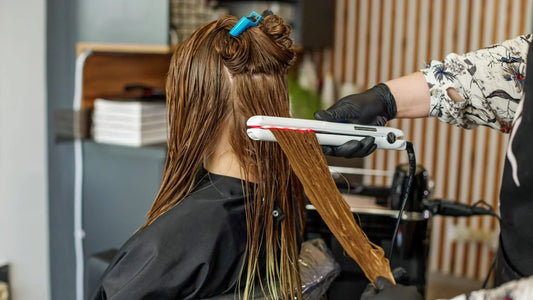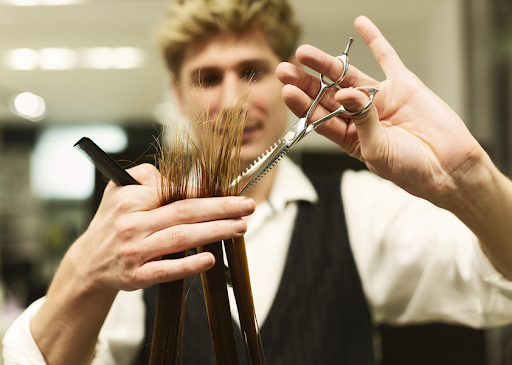Table of Contents
- Understanding What Are Split Ends
- What Causes Split Ends?
- Frizz That Doesn’t Go Away After Conditioning
- Hair That Tangles or Knots Easily at the Ends
- Uneven Texture When You Run Your Fingers Through
- Thin or See-Through Tips While Roots Stay Thick
- Dull Ends While Roots Stay Shiny
- Types of Split Ends You Might Be Seeing
- What to Do If You Spot These Signs
- Visual Recap: The Sneaky Signs of Split Ends
- Conclusion: Catch Them Early, Protect Your Length
- Frequently Asked Questions
When you think of what are split ends, you may picture a strand neatly split in two. In reality, split ends often show up long before that clear “Y” split appears, quietly damaging your hair and leading to dead ends that force you to cut off inches.
Recognizing these early signs of split ends helps you take action before your hair’s health spirals, preserving length and keeping your hair looking its best.
Understanding What Are Split Ends
Before we dive into the sneaky signs, let’s clarify what are split ends.
Split ends happen when:
- The outer cuticle layer of your hair wears away.
- The inner cortex becomes exposed and begins to fray.
- Strands lose moisture, elasticity, and smoothness.
What Causes Split Ends?
|
Cause |
Why It Leads to Splits |
|
Heat styling without protection |
Weakens and dries out the hair shaft |
|
Rough towel drying |
Causes friction and breakage |
|
Overwashing with harsh shampoos |
Strips hair of natural oils |
|
Chemical treatments |
Weaken and damage the cuticle layer |
|
Environmental exposure |
UV rays and pollution degrade hair fibers |
1. Frizz That Doesn’t Go Away After Conditioning
If you’re asking what are split ends and how to spot them, persistent frizz at your ends is an early giveaway. While frizz can be caused by humidity or product buildup, frizz that sticks around after deep conditioning often signals hair split ends forming.
Why Frizz = Hidden Splits
- Damaged cuticles lift, creating roughness.
- Hair refuses to lie flat, even when moisturized.
-
Ends appear puffy and uneven.
Pro Tip: Take a small section of hair, smooth it down, and check if the ends stay aligned. If they flare out, it could be the start of split ends.
2. Hair That Tangles or Knots Easily at the Ends
Another subtle sign you’re dealing with split ends is increased tangling and knotting, especially at the ends.
Why This Happens:
- Frayed strands act like hooks, catching on neighboring hair.
-
Rough cuticles prevent hair from sliding smoothly past each other.
Table: Tangle vs. Healthy Hair
|
Healthy Ends |
Ends with Split Ends |
|
Smooth detangling |
Snag and catch easily |
|
Minimal knots |
Frequent small knots at tips |
|
Curls separate easily |
Curls clump and mat at ends |
If you’re detangling carefully but still dealing with stubborn tangles at the ends, it’s time to check for split ends before they develop into dead ends.
3. Uneven Texture When You Run Your Fingers Through
You can learn what are split ends just by touch. Run your fingers from root to tip:
✅ Smooth and consistent? Your hair is healthy.
❌ Rough, gritty, or straw-like at the ends? You’re feeling early split ends.
Why Texture Changes:
- Raised cuticles create friction.
- Dry, damaged strands lose elasticity.
-
Frays along the strand feel uneven and coarse.
This texture change signals that hair split ends are forming beneath the surface, and it’s the perfect time to intervene with a split end treatment.
4. Thin or See-Through Tips While Roots Stay Thick
Healthy hair maintains consistent thickness from root to tip. If your ends look wispy or thinner than your roots, you’re seeing another early sign of split ends.
Visual Check:
- Hold your hair against a white background in natural light.
-
If the ends appear almost transparent while the upper section is dense, damage is progressing.
This thinning at the ends often goes unnoticed until your stylist points it out, but it’s one of the clearest signs of split ends leading to dead ends.
5. Dull Ends While Roots Stay Shiny
Healthy hair reflects light consistently. Damaged hair with split ends scatters light, making ends appear dull while roots look shiny.
Why Dullness Appears:
- Raised cuticles at the ends disrupt smooth reflection.
- Lack of moisture prevents shine.
-
Frayed tips lose luster and definition.
Check in the mirror: If your ends lack the glow your roots have, it’s time to consider a split end treatment.
Types of Split Ends You Might Be Seeing
Learning what are split ends includes understanding the different types of split ends that can appear:
|
Type |
Appearance |
|
Basic Split |
Classic Y-shape |
|
Forked Split |
Splits into 3 or more branches |
|
Tree Split |
Multiple splits on one strand |
|
Feather Split |
Fine splits, feather-like |
|
Knot |
Strand knotting onto itself |
[Read next: Types of Split Ends and How to Identify Them]
What to Do If You Spot These Signs
Prevention First:
- Switch to a satin pillowcase to reduce friction.
- Detangle with a wide-tooth comb on damp hair.
- Use leave-in conditioners and lightweight oils.
- Minimize heat styling, and always use a heat protectant.
- Hydrate regularly with deep conditioning masks.
Trimming Is Key
While oils and serums help improve appearance, trimming is the only permanent solution to split ends. Tools like the Split Ender allow you to trim only the damaged ends, preserving your length while eliminating damage.
|
Action |
Benefit |
|
Deep Conditioning Weekly |
Restores moisture, reduces dryness |
|
Regular Light Trims |
Removes split ends before spreading |
|
Gentle Detangling |
Prevents further damage |
|
Leave-In Products |
Protects and hydrates ends |
Visual Recap: The Sneaky Signs of Split Ends
- Frizz that doesn’t go away
- Increased tangling at ends
- Rough, straw-like texture
- Thinning, see-through tips
- Dull ends with shiny roots
Spotting these signs early can save your hair length, reduce dead ends, and improve your hair’s health and appearance over time.
Conclusion: Catch Them Early, Protect Your Length
If you’ve been wondering what are split ends, you now know they’re more than just split tips. They’re a progression of damage that shows up as frizz, tangles, texture changes, and dullness before you ever see the classic Y-split.
Taking action when you see these early signs will protect your length, save you from drastic cuts later, and keep your hair looking healthy and full.
Next Steps:
- Adopt a protective routine with hydration and gentle handling.
- Use tools like the Split Ender to remove splits without losing length.
- Track your progress by checking for these signs monthly.
Frequently Asked Questions
What are split ends, and can they be fixed?
Split ends occur when the protective layer of your hair is damaged, leading to fraying of the strand. They cannot be repaired, only trimmed.
How often should I trim to avoid split ends?
Trimming every 8–12 weeks helps prevent splits from worsening and traveling up the strand.
Do oils and serums repair split ends?
They can temporarily smooth and hide the appearance of splits but do not permanently fix them.
Can split ends affect hair growth?
While they don’t stop hair from growing, split ends can lead to breakage, making it difficult to maintain length.
What is the best treatment for split ends?
Consistent hydration, protective styling, and regular trims using tools like the Split Ender provide the best prevention and management.
Keep Learning & Take Action
- How to Cut Split Ends Without Losing Length
- Best Split End Treatments That Actually Work
- Best Products for Split Ends: What Actually Works (and What Doesn’t)
Understanding what are split ends and how to spot them early is your first defense in protecting your hair’s health and length. Don’t wait for the obvious frays, your hair deserves proactive care to stay strong, smooth, and beautiful.




